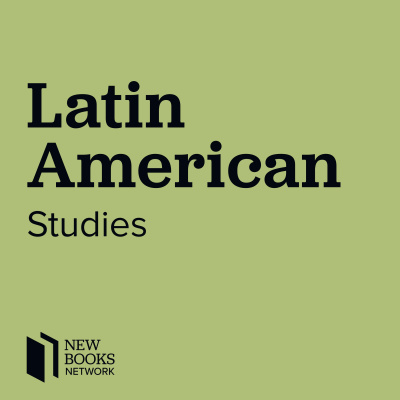Sinopsis
Interview with Scholars of Latin America about their New Books
Episodios
-
Alina Garcia-Lapuerta, “La Belle Creole” (Chicago Review Press, 2014)
18/02/2015 Duración: 37minOne of the fundamental functions of biography is the preservation of stories. But it also acts to resurrect the stories that may have fallen from view, reinvigorating the tales of people who, with the passage of time, have become merely names on plaques. In La Belle Creole:The Cuban Countess Who Captivated Havana, Madrid, and Paris (Chicago Review Press, 2014), Alina Garcia-Lapuerta aims to do just that: vividly drawing the story of Mercedes Santa Cruz y Montalvo, a woman who was tremendously famous during her lifetime but who has since fallen into relative obscurity, especially in America. Many Cubans and Cuban Americans will be familiar with her name, but many others will never have heard of her, a misfortune thatGarcia-Lapuerta’s work will hopefully correct. Just on the surface, there’s a compelling plot: a Cuban girl leaves home and meets with social triumph in Europe, where she is hostess of one of the most famous salons of her day. But its the theme of ex-patriotism, whichGarcia-Lapuerta (an
-
Erik Ching, “Authoritarian El Salvador: Politics and the Origins of the Military Regimes, 1880-1940,” (University of Notre Dame Press, 2014)
03/02/2015 Duración: 01h17minDuring the 20th century, El Salvador suffered from one of the longest periods of military rule and political domination in the Americas, beginning with the 1931 coup against the democratically-elected Arturo Aurajo, and culminating in a bloody civil war that lasted from 1979 to 1992. In Authoritarian El Salvador: Politics and the Origins of the Military Regimes, 1880-1940 (University of Notre Dame Press, 2014), Erik Ching examines the origins of this history of authoritarian governance in the late 19th and early 20th Centuries. What he reveals is a seemingly paradoxical political system, in which frequent elections and high voter turnout and political engagement coexisted with frequent coups and a near-total lack of actual democratic influence on governance. This system led to a peculiar national understand of “democracy” that colored the behavior of El Salvador’s military rulers. Marshaling a wide range of documents, including electoral records, political correspondence, and press articles,
-
Charles F. Walker, “The Tupac Amaru Rebellion” (Harvard UP, 2014)
23/12/2014 Duración: 38minCharles F. Walker‘s book The Tupac Amaru Rebellion (Harvard University Press, 2014) charts the rise, fall, and legacy of a massive uprising in colonial Peru. Indigenous societies in the Andes labored under heavy taxes, tributes, and discrimination imposed by the Spanish imperial state. Walker’s monograph follows the rebellion of a multiethnic group of indigenous, mestizo, and creole subjects, led by José Gabriel Tupac Amaru in 1780. Along with his wife Micaela Bastidas, Amaru’s leadership posed a serious challenge to Viceroyalty of Peru. Although ultimately unsuccessful, Amaru’s rebellion inspired and gave strength to other uprisings in the Andes. With an engaging narrative of the rebellion’s progress, Walker provides a vivid explanation of one of the largest and most important colonial rebellions in the eighteenth-century Americas.Learn more about your ad choices. Visit megaphone.fm/adchoices
-
Alex Nading, “Mosquito Trails: Ecology, Health and the Politics of Entanglement” (University of California Press, 2014)
18/12/2014 Duración: 54minDengue fever is on the rise globally. Since it is transmitted by mosquitoes which reside and reproduce in human environments, eradication efforts involve households and the people who keep them clean as well as moral and persuasive campaigns of surveillance and invigilation. In his new book Mosquito Trails: Ecology, Health and the Politics of Entanglement (University of California Press, 2014), Alex Nading follows the trails of garbage collectors and recyclers, local health care workers, and the mosquitoes themselves in this fascinating ethnography of Nicaragua’s Ciudad Sandino’s efforts to deal with dengue fever. He argues that these efforts are better understood as a series of entanglements and attachments that bring human and more than human actors together in intimate relationships. Nading’s book offers readers new ways to think about the relationships among the state and local actors as mediated through a series of objects: houses, viruses, immune systems, insects, and allocation budget
-
Scott Mainwaring and Anibal Perez-Linan, “Democracies and Dictatorships in Latin America: Emergence, Survival, and Fall” (Cambridge UP, 2013)
15/12/2014 Duración: 21minScott Mainwaring and Anibal Perez-Linan are the authors of Democracies and Dictatorships in Latin America: Emergence, Survival, and Fall (Cambridge University Press, 2013). Mainwaring is the Eugene and Helen Conley Professor of Political Science at the University of Notre Dame. Perez-Linan is an associate professor of political science at the University of Pittsburgh. Why do authoritarian regimes survive or fall? Mainwaring and Perez-Linan’s answer that question with a comprehensive examination of decades of data on Latin America (1945-2005). They argue that normative pressures from domestic actors provide the most statistically significant answer. The book investigates the quantitative findings further with case study examinations of transitions from authoritarian regimes in Argentina and El Salvador.Learn more about your ad choices. Visit megaphone.fm/adchoices
-
Lyman Johnson, “Workshop of Revolution: Plebian Buenos Aires and the Atlantic World, 1776-1810” (Duke UP, 2011)
13/12/2014 Duración: 57minLyman Johnson‘s book Workshop of Revolution: Plebian Buenos Aires and the Atlantic World, 1776-1810 (Duke University Press, 2011) analyzes the economic, political, and social lives of working people in Argentina’s colonial capital. Johnson traces the economic challenges facing plebian workers in Buenos Aires, including competition from foreign goods, the arrival of enslaved Africans into the city’s economy, difficulties in labor organization, and transformations in colonial governance. It provides a vibrant explanation of the factors that helped to create an organized working class on the eve of Latin America’s independence movements. In many ways, his study provides a much-needed introduction to the social and economic factors that eventually resulted in Argentinian revolution.Learn more about your ad choices. Visit megaphone.fm/adchoices
-
Kathleen Lopez, “Chinese Cubans: A Transnational History” (UNC Press, 2013)
21/11/2014 Duración: 01h07minSuccessive waves of migration brought thousands of Chinese laborers to Cuba over the nineteenth and twentieth centuries. The coolie trade, which was meant to replace waning supplies of slaves, was but the first. In the twentieth century, a sugar boom in Cuba facilitated the entry of thousands more. Many of these itinerant workers stayed, and this book uses Chinese and Spanish languages sources and microhistorical methods to trace their lives as they married, raised children, formed associations and ran businesses. Kathleen Lopez‘s book Chinese Cubans, A Transnational History (University of North Carolina Press, 2013) asks questions about belonging and offers a nuanced interpretation of the ways people of Chinese descent could proffer loyalties to Cuba even as they were embedded in transnational Chinese networks. There are surprising stories here, about race, family and work. Next time you encounter a Chinese-Cuban restaurant, you’ll know a little more about how it got there.Learn more about your a
-
Caterina Pizzigoni, “The Life Within: Local Indigenous Society in Mexico’s Toluca Valley, 1650-1800” (Stanford UP, 2012)
13/11/2014 Duración: 51minCaterina Pizzigoni’s book The Life Within: Local Indigenous Society in Mexico’s Toluca Valley, 1650-1800 (Stanford University Press, 2012) provides a close examination of indigenous society in central Mexico. Analyzing more than 200 testamentary documents, Pizzigoni chronicles what Nahua homes looked like, who lived within them, and how indigenous households regulated their property and kinship connections. It is a fascinating portrait of daily life in an area that held firmly onto its Nahua traditions, while also incorporating certain aspects of Spanish imperialism. Her work provides vivid and detailed explorations of Nahua household practices in a period often overlooked in the history of Spanish colonization in Mexico.Learn more about your ad choices. Visit megaphone.fm/adchoices
-
Kirsten Weld, “Paper Cadavers: The Archives of Dictatorship in Guatemala” (Duke UP, 2014)
06/11/2014 Duración: 01h04minKirsten Weld‘s book Paper Cadavers: The Archives of Dictatorship in Guatemala (Duke University Press, 2014) tells the story of the 2005 discovery of a vast police archive in Guatemala. Officials had long denied that it existed, and for good reason, because it documented years of kidnapping and murder under the auspices of counterinsurgency. Weld’s book accounts for the repercussions of that discovery on many levels. It is at once an ethnography of human rights activists turned archivists, an argument about the centrality of the production of knowledge with regards to both repression and human rights work, and a gripping account of the debates and politics of Guatemala’s reckoning with the legacies of its Dirty war.Learn more about your ad choices. Visit megaphone.fm/adchoices
-
Marcia Ochoa, “Queen for a Day: Transformistas, Beauty Queens, and the Performance of Femininity in Venezuela” (Duke UP, 2014)
30/10/2014 Duración: 01h01minMarcia Ochoa‘s book Queen for a Day: Transformistas, Beauty Queens, and the Performance of Femininity in Venezuela (Duke University Press, 2014) is a detailed ethnography of Venezuelan modernity and nationhood that brings two kinds of feminine performances into the same analytical frame. Her focus on transformistas and beauty queens allows her to draw relationships among power, beauty, violence, and space. The book uses different orders of magnitude, moving from the national and transnational through the street and the runway and coming to rest finally on the body to work through arguments about mediation and the production of femininity. Ochoa’s work contributes to scholarship on politics and gender in Venezuela by understanding them as bound together and mutually constitutive. Along the way there are some searing and moving portraits of the people who are her subjects.Learn more about your ad choices. Visit megaphone.fm/adchoices
-
Gregory Weeks, “Understanding Latin American Politics” (Pearson, 2014)
08/10/2014 Duración: 48minWhat factors compel Central American residents to flee their home countries and head to the United States? What do national elections in Latin America mean, and why should the U.S. be concerned? Which Latin American nations are emerging international powers? These are some of the questions Dr. Gregory Weeks prepares students to answer with his book, Understanding Latin American Politics (Pearson, 2014). Dr. Weeks balances regional theories on political participation and economic development with unique circumstances within each Latin American state. Analyzing events on the local, national, and international levels, this synthesis demonstrates how actions at the local level impact the global community. In this interview we discuss Dr. Weeks’s book and gain insight into contemporary Latin American affairs, providing listeners with a theoretical and practical background to analyze future events in the Western Hemisphere.Learn more about your ad choices. Visit megaphone.fm/adchoices
-
Roger Kittleson, “The Country of Football: Soccer and the Making of Modern Brazil” (University of California Press, 2014) and Joshua Nadel, “Fútbol! Why Soccer Matters in Latin America” (University Press of Florida, 2014)
24/06/2014 Duración: 53minPassion. Flair. Instinct. Improvisation. As the World Cup advances to the knockout stage, you’ll hear these terms associated with the football styles of Brazil, Argentina, and Mexico rather than those of Belgium and Germany. As historians Roger Kittleson and Joshua Nadel explain, the soccer cultures of Brazil and other countries of Latin America have long been bound in such stereotypes. Their new books–Kittleson’s The Country of Football: Soccer and the Making of Modern Brazil (University of California Press, 2014) and Nadel’s Futbol! Why Soccer Matters in Latin America (University Press of Florida, 2014)–take these narratives apart, revealing that they often run counter to evidence from the past. Take, for instance, this matter of a Latin American playing style. As the sport gained popularity across the region in the early 20th century, so-called national styles were a matter of heated debate among journalists, coaches, and even academics. Rarely were national sides as purely &#
-
Omar Valerio-Jimenez, “River of Hope: Forging Identity and Nation in the Rio Grande Borderlands” (Duke UP, 2013)
12/06/2014 Duración: 01h55sHistorically speaking, who you were depended on who your rulers were and the ethnic identity (including language, religion, and folkways) of “your” people. In the era of nation-states–that is, our era–these two characteristics have, for most people, been fused. Ethnic Germans live in Germany, ethnic Chinese live in China, ethnic Egyptians live in Egypt. The exceptions to this rule are two: ethnic minorities (e.g., Jews, Kurds, Uyghers, etc.) residing in nation-states and people who live in the shifting borderlands between nation-states. Omar Valerio-Jiménez‘s fascinating book River of Hope: Forging Identity and Nation in the Rio Grande Borderlands (Duke University Press, 2013) is about identity in one particularly interesting shifting borderland, that found in the Rio Grande region between New Spain/Mexico and the United States. Valerio-Jiménez shows that the people of the Rio Grande were, ethnically speaking, many: a variety of native Americans, Spanish soldiers and colonists,
-
Cymene Howe, “Intimate Activism: The Struggle for Sexual Rights in Postrevolutionary Nicaragua” (Duke UP, 2013)
10/06/2014 Duración: 01h10minWith Intimate Activism: The Struggle for Sexual Rights in Postrevolutionary Nicaragua (Duke University Press, 2013), Cymene Howe offers an ethnography of activism. Woven into Nicaragua’s political history of revolution and U.S. intervention, the struggle for sexual rights there takes place on three stages: in intimate settings of lesbian discussion groups, in the public sphere marked by demonstrations, press conferences and celebrations, and in visual and print media. Howe’s informants (activists, advocates, students, educators, television actors, members of Nicaragua’s queer community) illustrate the transformations and continuities in the culture of sexuality in Nicaragua.Learn more about your ad choices. Visit megaphone.fm/adchoices
-
David Nemer, “Favela Digital: The Other Side of Technology” (GSA Editora e Grafica, 2013)
05/06/2014 Duración: 38minInherently problematic in most mainstream discussions of the impact of technology is the dominant western or global northern perspective. In this way, the impact of technology on societies in developing countries, the impact of these societies on technology, and how those technologies are used is often ignored or marginalized. In his book Favela Digital: The Other Side of Technology (GSA Editora e Grafica, 2013), David Nemer, a doctoral candidate in Social Informatics at Indiana University, analyzes the ways in which the people of the slums in Brazil are using technology. Using photography as the dominant medium, Nemer explores the questions of whether, and how technology is a tool for both empowerment and disempowerment.Learn more about your ad choices. Visit megaphone.fm/adchoices
-
Daniel Altschuler and Javier Corrales, “The Promise of Participation” (Palgrave-MacMillan, 2014)
21/04/2014 Duración: 18minDaniel Altschuler and Javier Corrales are the authors of The Promise of Participation: Experiments in Participatory Governance in Honduras and Guatemala (Palgrave-MacMillan, 2014). Altschuler is a visiting scholar at the New School for Public Engagement, while Corrales is professor of political science at Amherst College. Participatory governance has long drawn the interest of scholars in political science. The promise of increasing civic engagement through institutions that allow citizens to participate has been studied extensively, but often in urban environments. Altschuler and Corrales build on this literature, but shift to rural parts of Honduras and Guatemala. The book focuses on Community Managed Schools and the participation of parents in school administration. They find that there were positive impacts on organizational learning and civic engagement for participating parents. You can view a short video from the book here.Learn more about your ad choices. Visit megaphone.fm/adchoices
-
Jason Ruiz, “Americans in the Treasure House: Travel to Porfirian Mexico and the Cultural Politics of Empire” (University of Texas Press, 2014)
11/04/2014 Duración: 58minIn Americans in the Treasure House: Travel to Porfirian Mexico and the Cultural Politics of Empire (University of Texas Press, 2014), Jason Ruiz explores the role of a distinct group of actors in the relationship between the United States and Mexico: American travelers, travel writers and photographers who visited and worked in Mexico during the late nineteenth and early twentieth centuries. With the junction of rail lines between the United States and Mexico in the 1880s, travel to Mexico became accessible to many in the populous U.S .East and Midwest. Through their photography and written accounts, These new travelers produced a popular representation of Mexico to the U.S. public which influenced both contemporary U.S. policy and modern U.S. attitudes towards Mexico. Drawing on the vast body of documentation and representation left by American travelers to Mexico, Ruiz argues that these travelers helped shape a form of U.S. cultural and economic imperialism distinct to Mexico. Travelers replicated many of t
-
Miranda Spieler, “Empire and Underworld: Captivity in French Guiana” (Harvard University Press, 2012)
28/03/2014 Duración: 55minIn Empire and Underworld: Captivity in French Guiana (Harvard University Press, 2012), historian Miranda Spieler tells of the transformation of a slave plantation colony into a destination for metropolitan convicts in the eight decades following the French Revolution. Unlike the better-known case of British Australia, French Guiana failed to turn...Learn more about your ad choices. Visit megaphone.fm/adchoices
-
Virginia Garrard-Burnett, Terror in the Land of the Holy Spirit (Oxford UP, 2011)
17/03/2014 Duración: 41minI have a colleague at Newman who takes students to Guatemala every summer. Since I arrived she’s encouraged me to join her. I would stay with the order of sisters who sponsor our university. I’d learn at least a few words of rudimentary Spanish. And, she says, if I’m really interested in genocide, I must visit this complicated, conflicted country. I’ve always declined (granted, I’m usually taking students to Europe, so I have a good excuse). However, after reading Virginia Garrard-Burnett’s excellent description of Guatemala in the early 1980s, I may have to say yes the next time. Burnett does an extraordinary job of making the complex politics of Guatemala understandable. Terror in the Land of the Holy Spirit: Guatemala under General Efrain Rios Montt 1982-1983 (Oxford University Press, 2011) is at least partly a biography of Rios Montt, and an excellent one. Burnett’s explanation of Rios Montt’s complicated personality and the influence religion played on
-
Jose Angel Hernandez, “Mexican American Colonization during the Nineteenth Century” (Cambridge UP, 2012)
06/03/2014 Duración: 01h21sAmericans talk a lot about the flow of Mexican immigrants across their southern border. To some that flow is seen as patently illegal and dangerous. To others it’s seen as unstoppable and essential for the functioning of the U.S. economy. Everyone agrees that something must be done about it though, in fact, little is ever done. It’s an American problem that seems to have no American solution. But, as Jose Angel Hernandez points out in his pathbreaking book Mexican American Colonization during the Nineteenth Century: A History of the U.S.-Mexico Borderlands(Cambridge University Press, 2012) , it’s not just an American problem: it’s also a Mexican one and always has been. In the wake of the Mexican American War (1846-48), the United States appropriated a huge chunk of what was Northern Mexico. This act of–what else can you call it?–naked imperialism left a lot of Mexican citizens stranded across the new border. The Mexican authorities might not have been able to get their ter

































